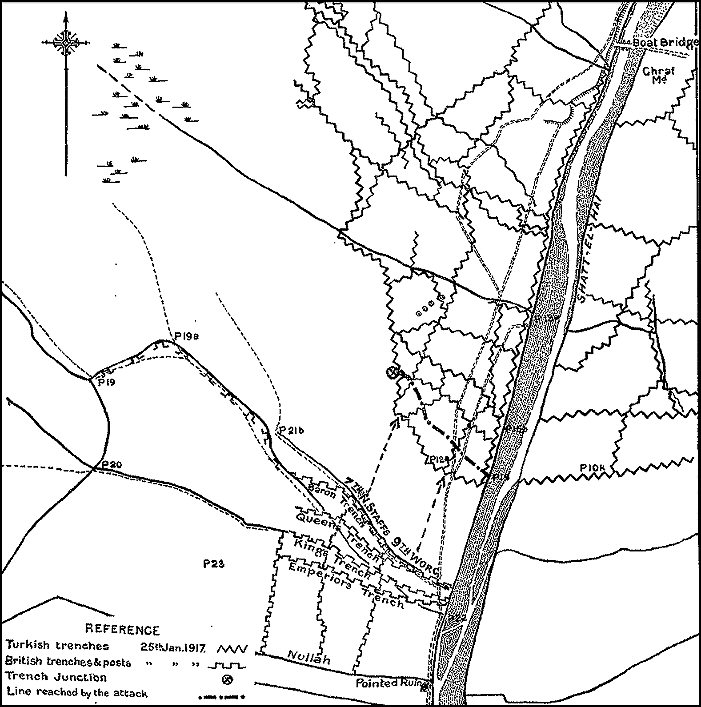9th Battalion Worcestershire Regiment - 1917
Throughout the first fortnight of 1917 the gunfire of the British artillery increased in intensity, while preparations were made for a systematic attack on the Hai Salient. After a fortnight in the flanking defences (The Battalion was relieved from the flanking defences by the 37th Dogras on January 11th and marched back to "Worcester City" [R.19] where the Battalion remained till January 16th) and in reserve at "Worcester City" the Battalion again took over (from the 7th North Staffordshire on January 15th) the former position on the right of the line, abutting on the banks of the Hai.
In preparation for attack on the Hai Salient a system of trenches was now being prepared in front of the nullah by the Pointed Ruin. Those trenches were constructed in successive parallel lines, to act as assembly trenches for the proposed attack. Their construction was pushed on with all speed, by sapping in daylight and by digging in the open at night (That digging by night was very dangerous. The digging parties were under the close fire of the enemy and casualties were frequent, especially among the subalterns in charge of the work. 2/Lieut. P. W. Harrington was killed on the night of January 15th/16th and 2/Lieut. A. A. Pine was killed on the following night), until half the gap between the Pointed Ruin and the apex of the Hai Salient had been covered. By January 21st the new trenches were within 300 yards of the enemy's front line, and assault was possible. The new trenches stretched row behind row; "Queen's Trench" , "King's Trench" , "Emperor's Trench", they were entitled. Headquarters of the 9th Worcestershire were established in the front line by the river bank.

The Hal Salient (25th January 1917)
Heavy rain on January 22nd postponed operations but the postponement enabled arrangements to be made even more complete.
None doubted that a hard fight was in prospect. It was certain that the enemy would make every effort to hold their position. Our airmen had reported new lines of trenches under construction within the Hai Salient and it was certain that the defenders had been strongly reinforced (The enemy's strength facing the attack was estimated as follows on January 21st:—Hai Salient—3,700 and 4 guns. Kut Peninsula—1,700 and 29 guns. Shumran Bridgehead and the Dahra Bend—4,400 and 18 guns).
The attack was planned in two phases; a preliminary attack against the southern apex of the Hai Salient by the 39th and 40th Brigades on the western and eastern banks respectively, followed by an attack of the 38th Brigade against the Salient's eastern face.
The attack of the 39th Brigade on the western bank of the Hai was to be made by two battalions, the 9th Worcestershire and 7th North Staffordshire. The other two battalions of the Brigade would be ready to reinforce.
On the night of January 24th/25th the two attacking battalions concentrated in the forward trenches; by 9.0 a.m. next morning all was ready.
